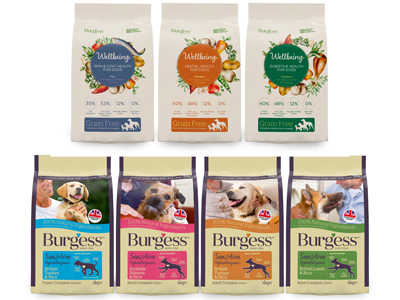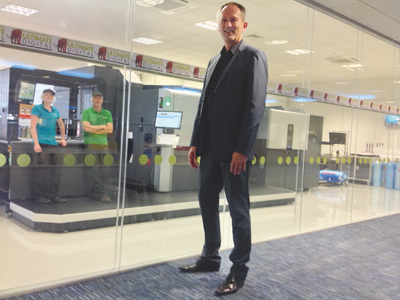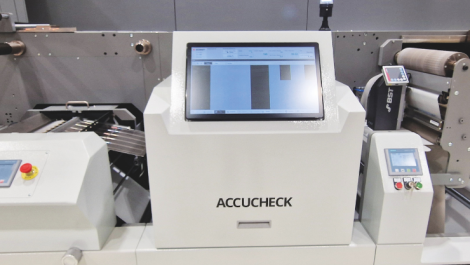Chris Tonge with Ultimate’s HP 20000 press
Interview with executive director of Ultimate Group, Chris Tonge.
Who says the Lincolnshire coastal town of Grimsby doesn’t ever receive a good press? Whilst it may have been recently sent up by anarchic comedian Sacha Baron Cohen, or else put down at the bottom of a list of places where people might choose not to live in the UK, it does lay claim to at least one shining light piercing the otherwise perceived gloom. With a £45 million sales turnover, and a customer base that includes many of the country’s top food retail names, the Ultimate Group is leading the rest of the pack in taking flexibles into an exciting new future. In addition to its ongoing investment in state of the art digital print technology, the Group’s in-house creative agency Sharp Iris is now working with many global brands to deliver exciting digital projects worldwide.
Executive director Chris Tonge talks to Des King about what it’s like to be taking a digital journey that is the envy of the Ultimate Group’s competition.
When and why did you extend into digital print?
We started to look at it about five or six years ago before installing the first HP press (a WS6600) in 2012 specifically to produce flexible packaging. We saw that whilst the labelling sector was already being well covered by digital, it was a brand new technology in a market within which we had considerable experience. HP had the best solution, well in fact the only, solution at that time for flexible packaging, so we became a beta test site at the start of the next stage of its own development process.
HP was clever about how it moved into flexibles in that it identified companies like us across the world that obviously knew their stuff with regard to colour, film and laminates and the rest of it; these were mainly independents and forward-thinking operations that had an interest in developing the new technology with HP.
What were the main challenges you had to address?
At the time we thought it would be used to service a combination of both existing and new customers, but quickly realised that rather than looking to move existing business from conventional, we were actually far more focused upon developing new markets and new customers. Part of that was driven by the fact that the WS6600 press was only 340 mm wide, so 95% of what we were printing flexo wouldn’t fit onto it anyway. Also 75% of flexo goes into the high volume in relatively low value fresh and chilled food sectors, quite difficult for digital. However, following the installation of the wider format HP 20000 press two years ago, a number of customers are now placing digital print orders along with their conventional work.
As part of the plan to extend into digital, we also invested in a local design agency (now Sharp Iris) with great IT skills and some very clever people, so we were able to hit the ground running. They understood all about how to get files to the press and digital workflow and all those things that most of the conventional printers would struggle with even now. I think that’s probably why there’s no other flexible packaging printer who’s seriously gone into the digital market in the UK yet.
We likewise took people from within the artwork and repro industry to run Ultimate Digital as they had a compatible background skill. I think that going at it the other way, namely getting a flexo operator to switch across would have never worked.
And what have been the main gains?
Digital will account for a £1 million turnover this year. By comparison with the £44 million we generate via our flexo operation it’s still quite small, but it has a far better margin. Plus it’s growing and we’re looking to ramp it up quite a bit over the next 12 months. Apart from being able to meet demands for short run and on-demand print, we’re now uniquely positioned to play a key role in the realisation of brand marketing campaigns linked to e-commerce and social media.
We’re still at 20 m/min speeds so it’s got a long way to go to actually compete head-on with flexo and other conventional technologies, but I’m quite happy with that at the moment since it makes digital complementary. As it goes faster, however, it’ll increasingly be considered as a replacement. One of the main reasons for our getting into digital originally was to stay ahead of the competition and the inevitability of the whole industry going digital. It’s a no-brainer that as it goes faster why would you want to print via any other process.

Run of 500 bags of seven different varieties of dog food from Burgess Pet Care
How has customer awareness to digital developed over the years?
The ‘Share a Coke’ campaign showed what a big brand can do with a clever marketing campaign. Oreos and Bud Light are other examples of brands that have redirected a slice of their marketing budget to the pack. It’s definitely where the future is; more and more people are realising that traditional forms of advertising and promotion aren’t necessarily the solution. But that said, and whilst there’s rapidly growing awareness to digital worldwide, I think the uptake from UK brands has been disappointing. But, of course, it’s still early days.
The things that we’re able to do with digital print as part of the overall solution – transforming a physical pack into a digital experience and facilitating interaction between the brand owner and the consumer via printed technologies that link into the virtual and augmented world – make this a really exciting space for digital and one that we’re concentrating on.
You’re developing something from being a simple pack on shelf to part of a one to one connection with the customer. Once you start to link in with social media, you can do things on smartphones and that’s very exciting for the marketers. Conversely, a packaging buyer is not really going to be interested in digital print when it’s five or six times the price of conventional. If someone wants to start analysing the cost of each individual pack then I’d say that they’re probably not quite ready yet for digital print.
And how has digital helped you and them to develop your businesses?
Going digital has opened up the world for us; it’s taken us into many new markets, enabled us to develop many new ranges of products and introduced us to a different set of customers to whom I’m not really trying to sell conventional print, but instead digital campaigns, digital projects. It’s raised the profile of Ultimate enormously.
Whereas flexo talks to procurement, digital talks to NPD and marketing. If a brand wants to test a new product in the market then digital is the obvious means of delivering a cost-effective short run. Likewise, it’s an ideal solution for smaller or start-up brands that are wanting to try something out without committing a major investment. Even larger brands are using the technology for test marketing purposes.
What advice would you give to anyone adopting digital now?
That you’d have to appreciate that it’s a completely different technology – and you’ve got to accept that there’ll be teething issues. I’d also suggest that you may be two or three years too late! To me, it’s a completely different business model from conventional print; that makes it a really exciting space to be in. But it’s one that requires a mindset with which a lot of conventional converters can really struggle. It’s likely that more people from outside the traditional print packaging sector will get involved in the future.
How do you see the future for digital print for packaging?
Lots of conventional press companies are now starting to develop very exciting things in the digital arena. I think that every major player has probably got to look at it because I seriously believe that eventually everything will be digital.
There’s inkjet and then there’s Landa, of course. If Benny delivers, then to me it’s going to be a game-changer. Printing 200 m/min makes digital a replacement rather than a complementary process, and then I think the industry’s got a serious challenge with regard to what do they do with conventional technology.






